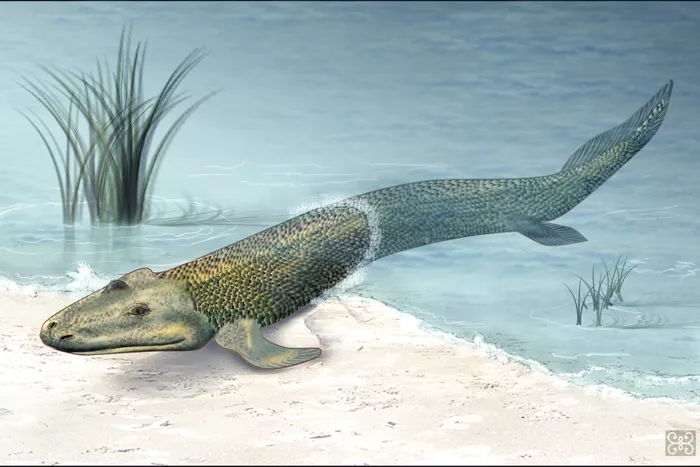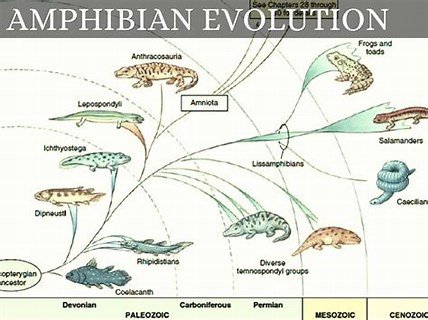Amphibians – Evolution and Ecology Study Guide
Introduction:
Amphibians are species from the Class Amphibia of the Phylum Chordata. These are a diverse class of animals, such as frogs, toads, salamanders, caecilians, etc., that can live both on land and in water. They possess soft and sticky skin and respire through their gills and lungs.
Evolution of Amphibians:
THE DEVONIAN ERA
- The earliest amphibians evolved during the Denovian era, around 375 million years ago.
- Their ancestor was the lobed finned fish, similar to the present-day lungfish.
- Some of these fish developed the most primitive pair of lungs that helped them breathe the air when the standing and temporary pools were devoid of oxygen.
- Gradually, their fins evolved into pairs of limbs, and these fish species became ancestors to all the tetrapods, including the amphibians, birds, reptiles, mammals, etc.
ADAPTING TO STAYING OUT OF WATER
- Amphibians evolved from the adaptations that permitted them to stay out of the water for much longer periods.
- Their lungs upgraded, and skeletons became more heavy and strong, making them better at supporting their respective bodies’ weight on the land.
- They also gradually started developing ‘hands’ and ‘feet’ with four or more pairs.
- Their skin had also become quite able to retain the body fluids and resist desiccation.
ADAPTING TO TERRESTRIAL ENVIRONMENTS
- In the Carboniferous period, the carnivorous amphibians started adapting to the terrestrial environment and dominating them.
- They were the only tetrapods on the land and were on top of most food chains.
- Despite having developed lungs and limbs, most of them still had long tapering bodies and long tails.
- It was then that the amniotic egg started gradually developing and prevented the eggs from drying and breaking out.
- Thus as the amphibians started to evolve from lungfish, the amphibians started to make new adaptations on land and develop their locomotions.
ADAPTING TO CHANGING ENVIRONMENTAL CONDITIONS
- Adapting to water conditions was different from adapting to land conditions.
- Both required different areas of development.
- The vertebral columns, lungs, and limbs that helped in locomotion needed to develop more in order to adapt to the land.
- They also needed to develop new methods and conditions to cope with the ambient and surrounding temperatures.
- Their skins were also exposed to the harmful UV Rays from the sun, previously protected in the water.
- The skin also changed to withstand excessive heat and prevent excessive water loss.
The Ecology of Amphibians:
- The amphibians can be found in freshwater and moist terrestrial regions of many habitats worldwide.
- Antarctica and Greenland are the only 2 regions on the planet that are not inhabited by the species.
- Species within the Order Anura are the most widely distributed ones.
Frogs can be found in a variety of habitats.
- Although they require a body of water to reproduce, they can surprisingly be found in grassy meadows and even in the deserts.
- In the more arid environments, they are able to make use of temporary and small pools of standing water when it comes to reproduction.
- They are also highly abundant in wet, humid, tropical areas such as rainforests, lakes, and ponds in temperate regions.
The salamanders and newts have a more restricted distribution:
- They are generally concentrated in the northern regions of the temperate zones in North America, Europe, and Asia. However, they are not restricted to this area.
- There are small sets of populations found even in the African and the South American continents. The largest variety is found in the United States.
- They generally live in ponds, lakes, streams, but several species can even reproduce in moist terrestrial environments. They do not require a standing body of water.
Caecilians live in an existence that is more earthworm-like than more amphibian-like.
- They are burrowers that use their head to dig the ground.
- They can be found living in soils near rivers and streams in tropical regions of Africa, Central and South Asia, and South America.
Conclusion
- The amphibians, within their ecosystems, play very important roles as predators and prey both for other organisms.
- Most amphibians are carnivorous predators.
- Frogs primarily feed on insects, worms, etc, whereas salamanders feed on frog tadpoles and invertebrates.
- The caecilians feed on worms from within the soil itself.
FAQs:
1. What is the ecological role of amphibians?
Amphibians play a pivotal role in ecosystems as secondary consumers in many food chains. Tadpoles have a significant impact on nutrient cycling. Adult amphibians are the best biological pest controllers.
2. What evolutionary tools do amphibians have to be successful on land?
In order to be able to live on land, amphibians replaced gills with lungs as the respiratory organ. Other adaptations include skin that prevents water loss, eyelids that allow them to adapt to vision outside water, and limbs as the locomotory organ.
3. What are the three reasons for protecting amphibians?
Amphibians play an important role in nature as prey and predators. They eat pest insects, which benefits agriculture worldwide and helps minimize the spread of diseases.
4. Who proposed the amphibian ancestry theory?
It was proposed by Darwin to discuss evolutionary notions in his famous work ” A naturalist’s voyage around the world “.
5. Did amphibians evolve before reptiles?
Yes, amphibians evolved before reptiles. The first reptiles evolved from an amphibian ancestor at least 300 million years ago.
We hope you enjoyed studying this lesson and learned something cool about Amphibians – Evolution and Ecology! Join our Discord community to get any questions you may have answered and to engage with other students just like you! Don’t forget to download our App and check out our awesome VR classrooms- we promise, it makes studying much more fun!😎


